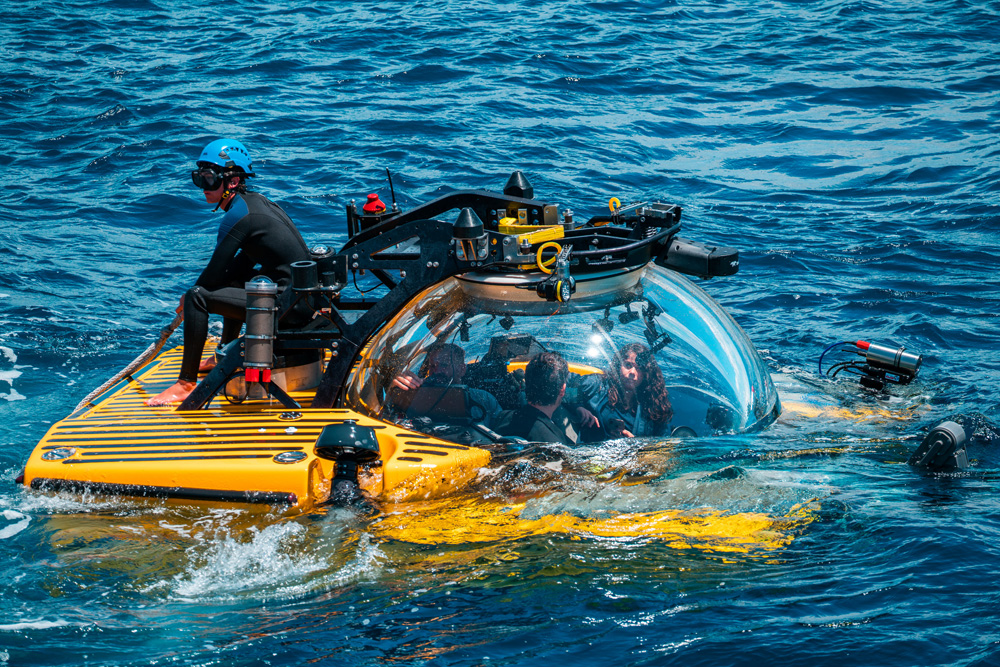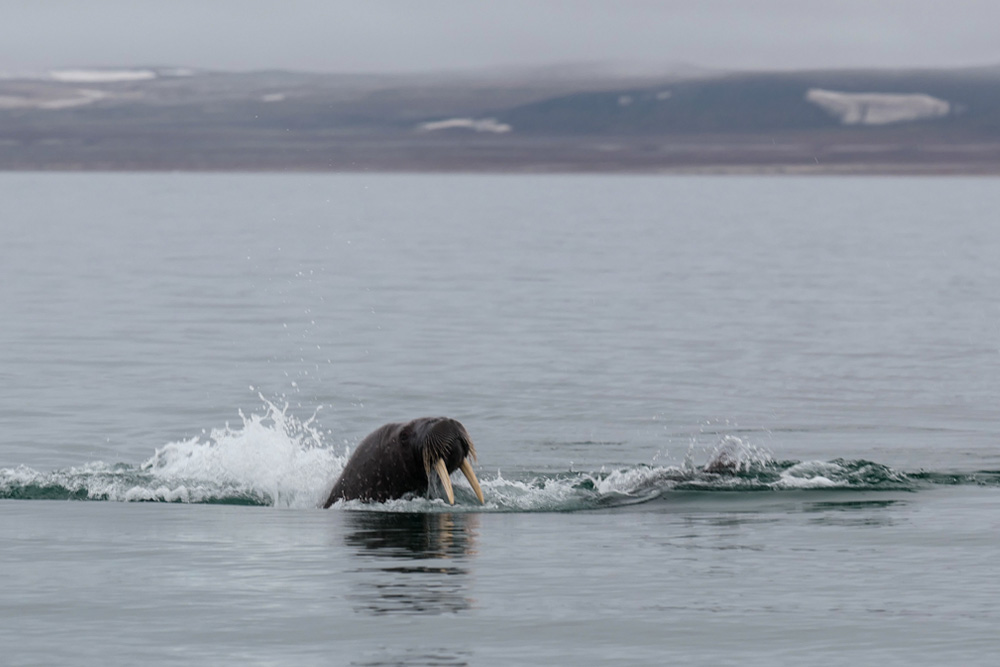
James Cameron has an unquenchable thirst for ocean exploration. Since 1995, the renowned filmmaker has dived the Titanic wreckage 33 times, and among his 70-plus submersible voyages, he’s visited the deepest place on Earth, the Challenger Deep, which lies 6.83 miles below the ocean’s surface. His investment and curiosity in the way of water has earned him an explorer of the year award and National Geographic’s prestigious Hubbard Medal, an honor that recognizes distinction in exploration, discovery, and research. Now Cameron has brought together the world’s top ocean experts, scientists, and production crew for OceanXplorers, a six-part discovery series that uncovers some of the ocean’s biggest mysteries.
“In OceanXplorers, we take viewers on an unparalleled ocean science adventure, introducing them to a group of principled, passionate people on a sometimes dangerous mission of ocean discovery in real time,” says Cameron. “We present the stakes, and firsts, and tell a visually spectacular and dramatic story – a story that inspires the next generation of explorers and adventurers committed to protecting and preserving our oceans.”
Aboard the high-tech research vessel OceanXplorer, the playground of the science-driven program travels from the tropical waters of the Caribbean and the shallows of the Bahamas to the depths of the Atlantic in the Azores region of Portugal before trekking to the frigid arctic shores of Svalbard, Norway. Equipped with submersibles, a helicopter, state of the art labs, and a futuristic mixed reality media center, the on-camera team – that included ocean researcher Zoleka Filander, marine biologist Melissa Cristina Márquez, mechanical engineer Eric Stackpole, and Aldo Kane, a trained Royal Marine commando – encountered unimaginable moments with hammerheads, humpback whales, orcas, walrus, polar bears, and creatures of the deep. The photography is breathtaking and visually immersive and it’s supported by an equally charismatic aural treatment. Undertaking the task of recording the production sound was Texas-based mixer Matthew Freed, UK-based mixer Nick Allinson, and New York-based mixer Michael Haldin.

Going into the project, Freed, whose credits include Swamp Mysteries, Fast N Loud, Undercover Boss, and Big Shrimpin’, says the sound team was able to capture the dynamic soundscape thanks largely to Zaxcom technology. “Given the complexities of the show and the variety of assets on the ship, it was critical to utilize the simultaneous onboard recording and transmitting of the Zaxcom wireless packs so any camera op or sound mixer could work with any cast at any given time in any location.,” says Freed, who landed the ambitious series through prior collabs with OceanXplorers executive producer and showrunner Brian Catalina.
Filming began in 2021 with the first of three voyages that took place throughout the year. The first expedition sent Freed and Allinson to the Dominican Republic in the Caribbean to reveal the secrets of the North Atlantic humpback whale and then on to the clear waters of Bimini in the Bahamas to witness the majestic journey of the hammerhead shark. In preparation for the spirited journey, Freed and Allinson were nervous about what the other might bring to the table in terms of experience, equipment, and expectations since it would be their first project together. Thankfully the duo are experienced with Zaxcom and had the same approach to capturing the audio. “Nick and I each had Zaxcom Novas, a couple dozen channels of wireless, URX100s, ZMT3-Phantom 2s for booms, plus numerous other pieces of gear to make it all happen,” notes Freed. “We each breathed a sigh of relief knowing that the gear was the least of our worries and we could focus on the creative and technical aspects of recording this show.”
The core audio package for OceanXplorers was designed around Zaxcom’s virtual multitrack capabilities. All three mixers used a Zaxcom Nova outfitted with dual MRX414 receivers that provided 8 channels of wireless audio per machine. Freed says, “The Novas acted as master controllers and multitracks for all the wireless transmitters deployed on cast and equipment. At any given time we could dial into any cast member and send audio to any camera or IFB.”

Sound also relied on multiple Zaxcom ZMT3-X, ZMT4, and TRXLA3.5 transmitters depending on the situation. For instance, when the submersibles were deployed to explore the deepest parts of the ocean, battery life became critical. “The submarines would dive up to 14 hours and typically consisted of a pilot plus two scientists. We wired each of them with a ZMT3-X and Sanken COS-11Ds and powered off the RF transmission to maximize runtime,” says Freed. “Then we had a Schoeps CMC 641 powered by a ZMT4 affixed to the bubble with a suction cup and shock mount.”
On any given day, the sound department deployed up to 18 transmitters to record the action above deck, underwater, on zodiac and rescue boats, scuba teams, helicopter flights, and glacier hikes – each adventurous situation presenting its own challenges. “The fact we were using Zaxcom gear and we were familiar with the capabilities of the equipment was massively important,” notes Freed. “Nick is an extremely accomplished underwater sound recordist so his knowledge of that realm, plus my experience with follow-doc made for a great partnership that accomplished all the tasks given to us by the production.”
While recording in tropical waters lavalier placement was key. “The talent is wearing shorts and thin shirts; very lightweight clothing, so the mounting was different from when we got to the North Atlantic and they are wearing cold weather survival gear,” says Freed. For the warmer climates the mixers would run a lav up the talent’s back and through hats. In colder temperatures, the wire placement goal was to avoid muffled sounds. “What’s great about all the Zaxcom gear is that it flowed from one environment to the next and it kept a consistent sound through the show,” says Freed.

Sound took advantage of the internal recording feature on Zaxcom transmitters which give the option to simultaneously transmit audio to a receiver. “We had a batch of three cards for every transmitter which we would download and transfer every day,” notes Freed. “Between the 12-15 cameras shooting 8K and 4K footage, our audio, and the helicopter footage, the amount of footage they generated was unreal.”
For the Norway portion, Haldin stepped in to mix. “I’ve worked with Michael on a ton of projects before and he’s also a Zaxcom user so it was a seamless transition,” says Freed. “Because of our familiarity with Zaxcom gear we each could walk into a situation, troubleshoot it, and get it done.” The team stayed in the arctic cold for two months capturing surreal footage of polar bears adapting to the effects of global warming, the mating habits of bowhead whales, and the feeding tendencies of the Greenland shark.
For a unique perspective with walrus, the audio team outfitted a sound capture system to a custom-made floating drone camera devised by cinematographer David Reichert. “David took a RED camera, placed it in a submersible Gates housing, put floats on it, then gutted drone controls and made an amazing remote controlled camera system that could be driven through the water and up close and personal to massively large walrus. They wanted audio on it, so we built a waterproof and walrus-proof housing with a ZMT3-X for the above-water stereo mics plus a TRX900AA to power a hydrophone to record whatever sounds the walrus would like to give us. It all worked amazingly well!” says Freed.
OceanXplorers is available to watch now on National Geographic, Disney+, and Hulu. Watch the trailer below: